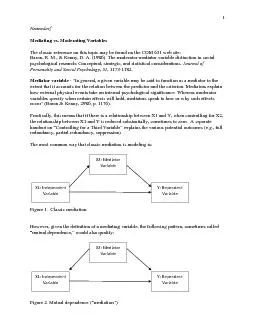/


Independent Dependent Independent Dependent lify as mediation under the Baron and Kenny definition this we might call ID: 124071
Download Pdf The PPT/PDF document "The classic reference on this topic may ..." is the property of its rightful owner. Permission is granted to download and print the materials on this web site for personal, non-commercial use only, and to display it on your personal computer provided you do not modify the materials and that you retain all copyright notices contained in the materials. By downloading content from our website, you accept the terms of this agreement.
The classic reference on this topic may be found on the COM 631 web site: Baron, R. M., & Kenny, D. A. (1986). The moderator-mediator variable diceptual, strategic, and statistical considerations. Personality and Social PsychologyMediator variable - "In general, a given variable may be said to function as a mediator to the significance. Whereas moderator variables specify when certain effects will hold, mediators speak to how or why such effects Practically, this means that if there is a relatiosubstantially, sometimes to zero. A separate plains the various potential outcomes (e.g., full The most common way that classic mediation is modeling is: Figure 1. Classic mediation. However, given the definition of a mediating variable, the following pattern, sometimes called mutual dependence, would also qualify: Figure 2. Mutual dependence (mediation) Independent Dependent Independent Dependent lify as mediation, under the Baron and Kenny definition; this we might call reverse mediation: Figure 3. Reverse mediation How can you tell which of the three is true?________________________________ - "In general terms, a mSpecifically within a correlational analysis framework, a moderator is a third variable that affects the zero-order correlation between two other variables. ... In the more familiar analysis of variance (ANOVA) terms, a basic moderator effect can be represented as an interaction between specifies the appropriate conditions for its Practically, this means that X2 makes a difference in terms of how and when X1 has an impact on Y. A moderator variable is one that changethis is that there is an interaction between X1 and X2 in the There is less agreement in the literature on how to display moderation in a model. Here is my favorite: Figure 4. Moderation (theoretic model) Independent Moderator Dependent Independent Dependent sting moderation through the inclusion of an interaction term in multiple regression and similar techniques, the following model would be appropriate: Figure 5. Moderation (with interaction term indicated) Interaction terms are common in the analysis of variance (ANOVA) family also be specified, as noted above, in multiple regressions and logistic regressions. The type of Some examples of interactions: Example 1. SOURCE: Wikipedia.com Independent Moderator Dependent x 4 Example 2. SOURCE: Furst, G., & Ghisletta, P. 5 Example 3. SOURCE: psych.hanover.edu Example 4. SOURCE: psychstat.missouristate.edu